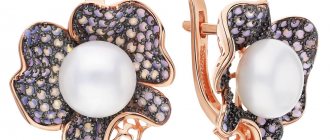Artistic products made using a special technology from glassy powder or enamel were well known in Ancient Rus'. Enamel in Rus' was called “khimipet” or “finipt”, the Russified form of which became the word “finift”. According to the famous scientist G.D. Filimonov (1828-1898), this term is of Byzantine origin, and is based on the Greek verb “hash”, meaning “to pour, melt”. Enamel occupied a special place in ancient Russian applied art; Chroniclers mentioned it with admiration, calling “gold with finipt”, used to decorate churches, “a wonderful vision.” Enamel, with its bright colors - blue, red, green - was intended to replace precious stones: sapphires, rubies and emeralds. The enamel technology, which combined the skills of an artist, a jeweler and a glassmaker, was very complex. The production of cloisonné enamel required special skill and art.
The production of jewelry with cloisonné enamel in Rus' began in the 11th century. The enamel got its name due to the use of the thinnest metal partitions, which were soldered onto the plate, creating the contours of the design. Enamel powder was poured into the resulting cells, which melted under high temperature.
Products with cloisonné enamel were first discovered in the 1820s as part of Kyiv treasures; Later, similar samples were found during excavations in other territories.
Studying the issue of Old Russian cloisonné enamel
Researchers studying the development of the art of cloisonne enamel in Rus' most often cite the book of the German monk or presbyter Theophilus “Treatise on Various Crafts” (11th century) as a source. Theophilus noted the achievements of Rus' in the complex matter of using cloisonne enamel and gave a detailed description of the sequence of technological operations in its manufacture. Theophilus' book contains information about the design of the furnace for making enamel, the process of firing the product, possible errors and methods for correcting them. The final stage of the process is described in detail - polishing the product, which requires certain skills and abilities. The only drawback of Theophilus's work is that the book did not say anything about how the necessary drawing was created.
The first scientific works, which provide an analysis of the origin of cloisonne enamel in Rus' and a description of jewelry with enamel, appeared in the middle of the 19th century. In 1853, Russian historian, archaeologist and collector I.E. Zabelin (1820-1908), called products with cloisonné enamel “works of Russian masters, students of the Byzantine Greeks.” Thus, a scientific direction in historiography was established, emphasizing the Byzantine influence on the development of Russian art of cloisonne enamel. The broad goal of Zabelin’s research is the history of metalworking in Rus' from the pre-Mongol period to the 18th century. – did not allow the author to dwell in detail on the description of the technology for making jewelry with enamel in Kievan Rus, but the topic aroused interest.
In 1861, a book by the famous Russian archaeologist and art historian G.D. was published. Filimonov (1828-1898) “The frame of the Mstislav Gospel”, where the author presented a detailed description of the frame with various enamel decorations. The scientist came to the conclusion that the enamel on the skillfully made frame belonged to different times of manufacture, starting from the 12th century.
Unfortunately, the author’s task did not include a detailed analysis of enamel, study of their designs and the technology of their production. G.D. Filimonov believed that the study of Russian-Byzantine enamel production represented a wide field for further research.
A complete analysis of enamel products was carried out by Russian archaeologist and art historian N.P. Kondakov in 1892. The scientist traced the history of the emergence and spread of cloisonne enamel, starting with ancient Egyptian and ending with ancient Russian. He came to the conclusion that Rus' adopted Byzantine and Eastern techniques, enriching their skills with them. Like Zabelin, Kondakov emphasized the importance of Byzantine influence on the development of Russian enamels production, but believed that the necessary basis for such development already existed in Rus'. Kondakov’s book “History and Monuments of Byzantine Enamel” is still considered the most complete and valuable work on the history of enamel.
An invaluable contribution to the study of cloisonne enamels was made by the Soviet and Russian archaeologist, researcher of the culture of Ancient Rus', academician of the Russian Academy of Sciences B.A. Rybakov (1908-2001). In the book “The Craft of Ancient Rus'” (1948), Rybakov considers the production of enamel as a special branch of artistic craft that independently developed in Rus'. Rybakov’s painstaking work on studying images from cloisonne enamel is presented in the work “Russian Applied Art” (1971). Considering the issue of Russian applied creativity, the academician came to the conclusion that artistic crafts in Rus' did not lag behind those of Western Europe in terms of craftsmanship, and in some areas even surpassed it.
Soviet archaeologist, researcher of culture and crafts of Rus' G.F. Korzukhina (1906-1974) compiled a collection of 175 archaeological sources on enamels, and devoted a number of articles to treasures and the technique of making cloisonne enamel.
A generalizing work on cloisonne enamels was compiled by the Soviet and Russian archaeologist and cultural historian T.I. Makarova (1930-2009), who classified ancient Russian treasures and developed a chronology of the development of cloisonné enamel production technology in Rus'.
Techniques for making objects with cloisonné enamel
The sequence of operations for the production of high-quality cloisonne enamels is described in detail by Theophilus. He indicated that one should begin by preparing the thinnest plate of gold. This art has been known since the existence of ancient states, where the skill of artisans, who were called goldsmiths or bratiarii, was famous. The task of gold miners was to flatten gold or silver using a hammer. Then the resulting sheet was cut into several parts, which were folded into a stack lined with pieces of parchment. The stack of sheets was again subjected to hammer blows until a thin plate of gold was obtained. After this operation, the size of the plate increased to twice its original size.
The next operation is to give the desired shape to the plate using a stencil and matrix. For example, the plate could be shaped like a kolta, that is, a pendant for a woman’s headdress. Theophilus described working with the stencil and matrix as follows: a stencil with the contours of the desired design was applied to the matrix, and a recess was imprinted on a gold plate, which served as a tray for the enamel. Further actions were as follows: “... you will cut them into the shape that you want to fill with enamel... you will very carefully and carefully place these leaves in their places and, having attached them with flour glue, place them over the coals. When you have filled one part, you strengthen it with extreme care so that all the delicate work does not melt.” Theophilus advised checking whether enamels of different colors could melt at the same time in order to prevent mixing of paints.
During excavations of monuments of Ancient Rus', stencils for making kolts were discovered in Kiev in 1907 (archaeologist V.V. Khvoika), and matrices for giving the plate a convex shape were found in different years in many places (G.F. Korzukhina; B.A Rybakov; T.I. Makarova).
Who suits it
Enamel looks especially good on older ladies and curvy women. The decorations themselves are all large and massive; they suit “royal persons” who look like rulers. Thick brown braid, rosy cheeks, sparkling eyes...
But even if you have a bob and your cheekbones are visible, don’t despair, elongated models will suit you. It’s quite difficult to find earrings, considering that almost all jewelry is sold online. It is much easier to choose a brooch or a ring, but it is much more difficult to make a mistake with a suitable shape.
Features of Russian enamel work: a combination of Byzantine and Russian traditions
Old Russian masters successfully used the traditions of Byzantine jewelry, where patterns for images were improved over the centuries. Perfection was achieved, for example, in conveying human movement with the help of draperies on clothing. In Russian jewelry with enamel, the Byzantine heritage can be traced in the use of eight techniques when applying partitions to products. Partitions in the form of corners and cells predominated; ovals, arcs, straight and zigzag lines, spirals and various ornamental figures were also used. It is believed that before placing the partitions in the tray, the desired shape was given to them on a special sketch, for example, on wax using a needle. The limited number of techniques for laying out partitions in products indicates that Russian production was standardized.
An important part of the enamel master’s work is filling the tray with pre-prepared enamel, tested for color and quality. Ready-made enamel could be bought from other craftsmen - this is exactly what enamellers in Rus' did from the 11th century: they bought enamel from Greek craftsmen who made multi-colored mosaics to decorate temples.
Masters of enamel crafts in Rus', improving their production and art, produced real masterpieces. Unfortunately, their names are unknown, but archaeologists and specialists in crafts and art note the bright individuality of individual products. A certain set of techniques, methods, and combinations of colors constituted the master’s secret, which was passed on to his children or students. Obviously, there were entire schools of masters of making products with cloisonné enamel with their own technology, set of tools and samples of patterns for ornament.
It is interesting that works made using primitive technology and a simple set of techniques were not discovered - already early products amaze with their perfection. Moreover, well-preserved kolta depicting the Sirins, which archaeologists attribute to the earliest, judging by the pagan subjects depicted on them, turn out to be the most perfect of all. True, in the early period there were also unsuccessful experiments by masters. Such an example can be seen in the Kiev Museum of Historical Treasures: this is a colt, where the master made a tray for the enamel that was too shallow, avoiding laying out the partition, as a result of which the enamel began to fall out.
Selection rules
Things with enamel are quite expensive. It's very disappointing to buy an expensive item that you can't wear. Therefore, you need to be able to choose the right product.
First of all, you need to decide on a style. Delicate openwork stained glass products are suitable for young girls. Older ladies should buy jewelry with geometric patterns. Large and multi-colored items are not recommended for overweight ladies. On thin fingers, large massive rings will also be inappropriate.
Blondes will suit delicate pastel tones. Brunettes should choose bright and rich multi-colored patterns. Red-haired ladies will highlight their style with warm shades of yellow, brick, red and peach.
If the style is selected, you need to examine the quality of the product. You should only buy jewelry in jewelry stores. In markets or shopping centers in Turkey you can buy low-grade silver or fake silver. In addition to the annoyance of wasted money, you can also develop an allergy. In a jewelry store, you need to ask the seller to show the product. It should not have any cracks, chips, bubbles, roughness or scratches. Nothing should seem unusual. Colors should be rich and uniform. There must be a sample on the product. If you wish, you can familiarize yourself with the quality certificate, which must be in the store.
Hot enamel is much more expensive. Therefore, it is important to make sure that it is exactly what you are buying. You can try to gently press the coating with your fingernail. Hot enamel will be hard and strong. There will be no pressure marks left on it. Cold-processed glass will give in and sag a little. Since cold enamel is not polished using technology, it may be uneven. Hot enamel also has a clear finish. If everything is carefully examined, the product looks neat and shiny, most likely it is real hot enamel. You can safely pay money for it. She's worth it.
Kiev school of making jewelry with cloisonne enamel and the formation of a unified tradition
According to T.I. Makarova, Kyiv craftsmen began producing jewelry with cloisonné enamel in the first half of the 11th century. They used the techniques of Byzantine craftsmen in making series of identical kolta with images of Sirens and birds and decorations in the form of cassocks. There were also single examples of jewelry repeating Byzantine subjects in the form of peacocks - such a subject is depicted on a kolta, distinguished by great craftsmanship.
Scientists believe that the first workshops for the production of cloisonné enamel could have included Russian and Greek craftsmen in the likeness of Greco-Russian glass or mosaic workshops. The first workshops produced high-quality, but stylistically monotonous kolta and cassocks: the design of the products, details, and enamel coloring were repeated. Basically, four primary colors were used: white, blue, red, light green - this once again confirms the opinion that the enamel was purchased in one specific place, most likely in Greek glass workshops in Kyiv.
The workshops were heterogeneous. Some of them produced standard quality jewelry and individual individual masterpieces; others specialized in jewelry with the same style, but of lower quality; still others worked with cheaper material, copper. The latter fact suggests that enamellers appeared among urban artisans.
The traditions of the school of the first enamellers, dating back to the second half of the 11th century, were developed in the next two centuries. Archaeologists discovered treasures that dated back to the second half of the 12th-13th centuries, but the found items with cloisonné enamel repeated the traditions of the first enamellers. The subjects of the images have changed: on the kolta, instead of Sirins and birds, images of saints appeared. B.A. Rybakov explains the change in subjects by the fight against paganism. The ornaments have also changed - they have become more complex, and the color scheme has become more varied. These changes are visible on the floral ornaments of the diadem of the second half of the 12th century depicting the ascension of Alexander the Great. The krin and branch designs are much more complex; the compositions are arranged in a mirror manner, which is reminiscent of the images on the Colts.
Over the century, there have been changes in the assortment of jewelry, which has become richer and more diverse. Regalia for various ceremonies - barmas, crowns and tiaras - were added to women's jewelry. Church decoration became more complicated; Gospel frames with cloisonné enamel frames began to be decorated more richly. An example is the Polotsk cross for church processions, where the image of Saints Stephen and Panteleimon was skillfully laid out using cloisonné enamel. This cross is known for the fact that it preserved the inscription of the master - Lazar Bogsha, the name of the customer - Princess Euphrosyne of Polotsk, and the date of manufacture - 1161.
Finifty contributed to the emergence of a style that B.A. Rybakov called it “enamel” - this is a style of multi-colored ornament, expressed laconically and perfectly. The style of cloisonne enamel was reproduced by artists working with mosaics and miniatures, laying out multi-colored ornaments, clothes and delicate faces on a golden background.
In the second half of the XII-XIII centuries. the drawings of some sets of barmas from the Kyiv group, which preserved the traditions of early enamels, have lost the complexity of execution and the multicolored color scheme.
After systematizing jewelry with cloisonné enamel made in Kyiv workshops, it was possible to identify their features and evolution. The characteristic features of Kyiv enamels include the use of a certain color scheme: blue was the main color, red and white were used in large quantities, green was an additional color. In the middle of the 12th century, which is considered the heyday of Kyiv enamel, the color palette was enriched with new shades and colors: blue was complemented by blue and ash, and new colors appeared - yellow and turquoise.
The subject matter of the images was reduced mainly to the depiction of saints; the previously used techniques were preserved and were complemented by a free manner of drawing, which gave the image greater picturesqueness. The craving for geometric techniques, the main of which were the angle and the cell, also remained.
The preservation of the continuity of traditions in the production of enamel for almost two centuries allows us to conclude that there is a single art school. What factors made it possible to ensure the long-term existence and functioning of such a school?
The appearance of a large number of princely and church regalia, the decoration of boyars and the top of ancient Russian society in archaeological finds with cloisonné enamel provides the answer to this question: the workshops were under the patronage of the authorities. A similar situation of workshops in Byzantium is recorded in many sources: jewelry workshops were state-owned, located on the territory of the emperor’s palace, and artisans attached to the workshops worked there. Their skill and belonging to the jewelry workshop were inherited.
There is no information about state or princely workshops in Russian sources. But the presence of different schools in different lands of Rus' confirms this possibility. An example is the enamel art of the Ryazan principality.
Ryazan and Chernigov cloisonne enamel
A few archaeological finds in Ryazan indicate the presence of workshops for the production of cloisonne enamel. Master enamellers preserved the traditions of well-established production and applied new techniques. Of particular value are the decorations found in Ryazan for church ceremonies and church decoration. For example, kolts were found to decorate icons with images of the first Russian saints Boris and Gleb, especially revered in the Murom-Ryazan land. The subjects on them combine secular and church motifs, and in this way they resemble the kolta from the Chernigov treasure discovered in 1887: they have common details and a “tree of life” ornament on the backing. But in terms of filigree and perfection of image application, the Chernigov koltas surpassed the Ryazan ones.
A feature of the Ryazan kolts, which distinguishes them from all ancient Russian enamel collections, is their size, weight and manner of manufacture. The size of the Ryazan jewelry is three times larger than the size of ordinary kolts found in other treasures, and the weight reaches 400 grams.
The unusual nature of the device is visible in the method of making the frame, reminiscent of barm frames: the gold base is covered with a filigree pattern with special sockets for precious stones. The jewelry is made heavier by a primitively inserted shield with enamel, which has special loops for a string of pearls. The large weight of Ryazan jewelry allowed Kondakov N.P. suggest that they were most likely used not as kolta, but as a pendant to the diadem on the icon's chasuble. It was not possible to find out which icon exactly.
The filigree of the frame is made excellently, but the cloisonné enamel of the Ryazan kolts has not reached a high degree of perfection. The images of the princes are made in a primitive manner: they are static, devoid of movement, their eyes look to the side, and their mouth is shaped like a “bow”. Enamels do not always have a clearly defined color, since the partitions are not closed and, obviously, enamels of different colors came into contact with each other during the production process.
The color scheme of Ryazan kolts differs from the Kyiv school in a poorer set of colors - they lack dark blue, light green, emerald and yellow. The leading color for Ryazan enamels is red, the additional color is white. There are more varied shades of blue, including three tones: dark blue, light turquoise and greenish blue.
An interesting example of cloisonne enamel are two barm medallions with Saints Irene and Barbara. The Ryazan master combined these two medallions with a medallion - an oranta (image of the Mother of God) of Byzantine work. Apparently, the image of St. Irene was patronal, since it was very rare. The master demonstrated jewelry skill by laying the partitions in the form of a grid with smooth, curving lines. A similar style was possessed by the Polotsk master Lazar Bogsha, who became famous for his perfect work in making a cross for Euphrosyne of Polotsk. The colors on Ryazan medallions maintained the local trend with a predominance of blue tones.
Despite their adherence to tradition, Ryazan jewelers became innovators in creating gold settings for products with enamel, which glorified local craftsmanship and made the products of the Ryazan school the best among their kind.
What products are popular
Such a variety of enameling techniques allows jewelers to realize their wildest fantasies. There are many varieties of silver and enamel products. The most popular are silver earrings and rings with enamel. Some ring designs are so quirky that you don't immediately know how to wear them. Many people prefer sets of jewelry created in the same style, in the same color scheme and with the same pattern. Such harmony allows you to make the image whole. In addition, sets make it possible to alternate jewelry without changing the overall style of clothing. Some girls, on the contrary, prefer to highlight and focus on the unique stained glass enamel ornament on the pendant.
The enameling technique is often used to create children's jewelry. Children love bright pictures. No other jewelry method makes it possible to create children’s favorite characters as closely as enameling. Therefore, most children's jewelry, silver spoons, drinking bowls and baby rattles are decorated with bright enamel. Earrings made of silver and enamel are very popular among children. On store shelves there is a huge selection of silver rings for little fashionistas. Various types of women's and men's jewelry are decorated with enamel coating.
Craftsmen cover complex patterns with enamel painting on silver dishes, boxes, cutlery, souvenir Easter eggs, icons, frames of mirrors and paintings. It is a pleasure for everyone to have such a valuable and beautiful thing at home.
Vladimir cloisonne enamel
The development of enamel work in Vladimir can be judged only by two discovered jewelry: these are two pairs of Colts. Their production shows the influence of the Kyiv school of enamellers, but at the same time they are distinguished by their originality, indicating the presence of their own, Vladimir, school. The main product of local workshops was, obviously, church utensils. In the chronicles she was called in one word “finipt”. So, in the Ipatiev Chronicle, it is said about the order of Prince Andrei Bogolyubsky to decorate the Church of the Nativity of the Virgin Mary with “great priceless pearls, gold and finipt.” The description of the church “finipt” has not reached us, but what is noteworthy is the fact that “finipt” is on a par with precious stones and gold.
The connection between the Vladimir school and the Kyiv school is shown by the images of Saints George and Dmitry, especially revered in Vladimir, found on two found kolta. The continuity of traditions can be seen in the techniques used to convey the clothes of saints, and in the geometric shapes used for design. But there are also differences: the shape of the Vladimir kolts is marked by originality, and the design is more rough than the Kiev one. The color palette of Vladimir cloisonne enamel bore the imprint of local traditions. The attempt of Vladimir masters to reproduce the complex ornament of Kyiv enamels was not entirely successful: the splendor of the design could not be accurately reproduced.
About Vologda enamel
Vologda (or Usolskaya) enamel is called painting on white enamel, the traditions of which have been preserved to this day. Solvychegodsk, Vologda province, is considered its homeland. Well, only later they started doing it in Vologda. The main theme of the painting is flowers, most often tulips. Although artists, in addition to flowers, also depicted birds, animals and mythological creatures.
The secret of making multicolor Vologda enamel was lost in the 18th century. After this, the enamel was made in one color - white, green and blue. And only in the 70s of the last century, Vologda masters began to revive the lost traditions of colored Usolsk enamel. It is successfully carried out today.
The art of Novgorod enamellers
Much more finds than in Ryazan were discovered in Novgorod. Among them are five square plates and icon cases from the setting of the Mstislav Gospel. Expeditions led by the famous archaeologist T.I. Makarova The people of Kiot discovered a Deesis from the frame of the icon of the Sign from the Sofia Sacristy, a copper icon with the image of Hypatius, and a gold plate with the image of St. George.
The list of finds is being updated and studied. But scientists have already come to a consensus that Novgorod masters created their own school of craftsmanship. The only thing that unites the Kyiv and Novgorod schools, as well as all other schools of enamellers of Ancient Rus', is the range of products. Highly artistic, first-class piece products were created by order of princes and other noble persons, and products of a wide range of lower quality were intended for the rest of the population.
Novgorod masters did not adhere to stylistic unity - this is their difference from the Kyiv masters. It is believed that the repeating compositions, uniform in design, belonged to the hand of the same master; such craftsmen could work in different workshops. However, there are two features that united the Novgorod workshops and distinguished them from other Old Russian enamellers - color and the use of partitions. The colors of Novgorod enamel repeated the bright and pure colors of local icon painting: blue, light blue, turquoise, red, green, yellow, and the distribution of partitions was free. Sometimes the partitions did not close; sometimes other combinations of geometric shapes were used to make enamel, different from Kyiv cloisonné enamel. The techniques favored by the Kyiv enamellers, based on the use of corners and cells, were not used by the Novgorodians.
Where did the Novgorod masters get their knowledge in making jewelry from cloisonne enamel, if continuity with the Kyiv masters is not traced? Moreover, the continuation of Kyiv traditions is not observed here. To answer this question, archaeological finds should be carefully studied. In particular, five square plates contain inscriptions in Greek, made using the inlay technique. This is direct evidence of Byzantine influence on the formation and development of enamel work in Novgorod. In addition, the enamel of the plate has an emerald color, which was also characteristic of Byzantine technology. Scientists suggest that the plates were made in the workshops of Novgorod, and the composition of the craftsmen included Greeks and Russians. The stylistic differences between Kyiv and Novgorod products can be explained by the fact that Greek craftsmen arrived in Kyiv and Novgorod from different places, since the enamel work of Byzantium developed not only in the capital and large cities, but spread throughout the empire.
Cloisonne enamel - the cultural heritage of Ancient Rus'
The enamel schools of masters in Kyiv, Ryazan, Chernigov, Vladimir and Novgorod left excellent examples of cloisonne enamel, but it is quite possible that the list of cities with developed production technologies is not complete. Probably, in other cities, workshops for making jewelry with cloisonné enamel existed for a short time for various reasons. Production could be created to order from a prince or church; they could be associated with the arrival of a famous master in the city. An example of short-term work is the workshop in Polotsk, where Lazar Bogsha created a cross commissioned by the princess. The lack of continuity can explain the few finds in various places: colt in Chernigov, enamels in Lyubech and others. But such finds have their own uniqueness, reflecting the characteristics of the place of manufacture.
A more persistent tradition in Rus' was the creation of enamel schools, which improved their skills and craftsmanship, were proud of their belonging to a special group of masters involved in the complex art of creating enamels, and passed on their skills to new generations of masters. That is why this art existed for several centuries, did not disappear during the Mongol invasion and continued the traditions of complex crafts in the post-Mongol era.
Jewelry with cloisonne enamel is part of the cultural heritage of Ancient Rus' and world heritage. The finds are carefully protected, studied, and exhibited in museums.
The vestments of Metropolitan Alexy of Kyiv and All Rus' (1354-1378) are kept in the Armory Chamber of the Moscow Kremlin. It includes a cross-shaped saccos made in Russia in the 14th century, striking with its amazing technique of sewn-on bezels, many of which are enamel. According to Academician B.A. Rybakov, some of the enamel inserts were made in the pre-Mongol period. The other part of the enamel inserts is distinctive, but still resembles the traditions of ancient Russian schools. The originality lies in the different manner of design of the ornament, vaguely reminiscent of birds, sirens, and the “tree of life.” The partitions look different - they are thicker and are located in deeper trays; a different color scheme was used. Surprisingly, some details of the enamel fragments of the epitrachelion of Metropolitan Alexy resemble the handwriting of not Kyiv, but Novgorod masters, in particular, the master from Novgorod who made the icon with St. Hypatius.
The similarity of traditions on other relics was also noted: some details of the ornament of the Vladimir kolta, the setting of the icon “Our Lady of the Sign” (16th century) from the Armory Chamber in Moscow and the small epitrachelium pellets from the Otrochiy Tverskoy Monastery are similar. Moscow and the latest enamels found - Tver, have no analogues. They clearly show traces of the decline of a once thriving industry; Obviously, the art of cloisonne enamel ceased to exist around the 13th-14th centuries, and Moscow and Tver became its last centers.
What is the significance of the art of cloisonné? It showed the possibility of borrowing technology for making artistic products. According to the apt statement of N.P. Kondakova, “every art begins with borrowing.” But having shown its readiness to perceive the most complex arts, Rus' created its own traditions and prepared the ground for further mutual influence. In the future, this will lead to the penetration into Russian culture of the best examples of stone architecture, sculpture and painting, after processing which Russian masters will create their own, original works. This happened with the art of cloisonné enamel, which in Rus' acquired peculiar unique features, becoming Russian cloisonné enamel.











